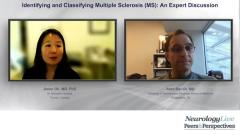
Emerging Treatment Options for Smouldering MS
Experts discuss current and emerging treatment options for multiple sclerosis (MS) highlighting the importance of treating early.
Episodes in this series

Transcript
Jiwon Oh, MD, PhD: Now that we have a better idea of some of the drivers of smoldering MS [multiple sclerosis], and there [are] many different complexities that you’ve highlighted that I’m sure we’ll learn more about in the coming years, but we actually have ways we can maybe even image some of the drivers of smoldering MS. What are some emerging therapeutic drug classes that may play a role in the coming years?
Amit Bar-Or, MD: Right, so what we would like to ideally accomplish is to limit the peripheral immune responses that contribute to relapse biology and at the same time target within the central nervous system [CNS] some or all of the processes that I’ve mentioned before. And as we’ve learned more about inflammation that contributes within the [CNS] to the smoldering injury and progressive disease, we’ve come to recognize certain cell types that seem to be potentially main drivers of these processes. And within the [CNS], we know that these immune cells in the meninges and the ependyma can often be rich with B cells of the immune system. And we know that cells within the tissue that are activated and maybe participating in injury include the microglial cells, both in the cortex and the periventricular regions, but certainly in the rims of these chronic active lesions as well. So therapeutic classes that might target 1 or more of these cells in combination within the [CNS], and not just in the periphery, would certainly have the prospect of being able to impact the unmet need. And one of the molecules that we know is abnormally active and upregulated in the context of MS is a molecule called BTK [Bruton tyrosine kinase]. And the BTK is particularly expressed in B cells and in myeloid cells, including both peripheral macrophages that are known to infiltrate lesions in MS but also in the microglial cells. And the overactivation of these cells with BTK playing a role makes it very attractive to think that targeting overexpression of BTK in the context of MS may have an important impact on both relapsing and nonrelapsing progressive biologists.
Jiwon Oh, MD, PhD: So, it sounds like the BTK pathway is a very interesting option for emerging therapeutics, and we do know that there are a number of clinical trials under way for agents that modulate the BTK pathway, so look forward to hearing more about those in the years to come. But are there other therapeutic drug classes? And I know there [are] many different emerging molecules in early stages of clinical development, but if you had to pick one or two different mechanisms that you think may eventually have an impact on smoldering MS, what drug classes would they be?
Amit Bar-Or, MD: [S]o I think that…of the classes that we are quite familiar with, we for instance know that the anti-CD20s as a class have a modest effect at best on the nonrelapsing smoldering disease and one possibility is because they have no role within the [CNS], but the other, which is more likely because we do think that B cells, their target[s] are present abnormally in the CNS and participating in progressive disease, it may be that these molecules are pretty large and the concentration gradient is insufficient, so there is some interest in increasing the dose and hoping that the medicine that works very well for relapsing disease and the periphery, if we could get more of it into the CNS, maybe it will work on nonrelapsing progressive disease, so that’s one approach. But as far as approaches that are targeting novel targets or pathways, there’s a lot of interest in costimulation. It’s not a novel pathway. It is one that attempts in the past to target it had been limited by adverse events and the new generation of therapies that target some of these pathways, including the CD40, CD40 ligand pathways, [for] example, has some promise because that too may be an approach that would impact limiting relapse biology in the periphery, but potentially also limiting the ongoing activation of immune cells within the [CNS] to the extent that they’re contributing to nonrelaxing progressive disease. I think that there’s also a lot of interest in cell-based therapeutics as sort of a totally different category of treatments, but the idea is that cell-based therapies have the prospect of going, as has been shown in the cancer world in particular, to many different tissues in the body and this could include the [CNS]. So, approaches administered in the periphery that may not access the CNS may be usurped by cell-based therapies that could go to places and then either kill cells there or deliver regulatory impact on local processes. And that field of cell-based therapies is one that is already being actively explored, but in sort of early steps and there’s a lot of interest in that prospect for the future.
Amit Bar-Or, MD: Well, it’s good to hear that there are so many different emerging molecules and classes of therapies that may have a beneficial effect beyond what we currently have.
Transcript was AI-generated and edited for clarity.
Newsletter
Keep your finger on the pulse of neurology—subscribe to NeurologyLive for expert interviews, new data, and breakthrough treatment updates.





































